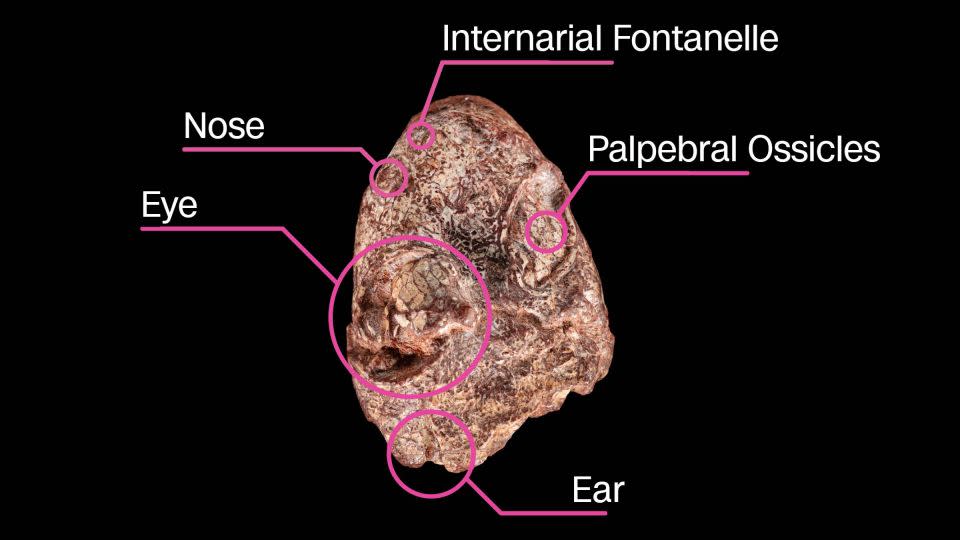Sign up for CNN’s Wonder Theory science newsletter. Explore the universe with news about fascinating discoveries, scientific developments and more.
Paleontologists at the Smithsonian National Museum of Natural History have discovered a previously unknown prehistoric species — a 270-million-year-old amphibian with big eyes and a cartoonish grin — and the name is a nod to an iconic frog-like celebrity.
Kermit the Frog meets Kermitops gratus, the latest ancient amphibian to be identified after examining a small fossilized skull that once sat unstudied in the Smithsonian fossil collection for 40 years, according to an article published Thursday in the Zoological Journal of the Linnean Society.
Kermitops predates the dinosaurs and is thought to have roamed the lower Clear Fork formation of Texas during the early Permian period from 298.9 million to 272.3 million years ago. The ancient amphibian’s skull, which measures just over an inch long, has large oval eye sockets and — because of its slightly crushed state — a crooked smile that researchers say reminded them of the Muppet icon.

The discovery of the new amphibian species could provide some answers to the question of how frogs and salamanders evolved to acquire their special features today, the authors wrote in the paper.
“One thing Kermitops really shows is that the origins of modern amphibians are a little more complex than some studies have shown,” said co-author Arjan Mann, a postdoctoral paleontologist at the Smithsonian National Museum of Natural History.
“And that really means that people need to keep studying these things, because just looking at museum collections, like this fossil, has the potential to change our ideas about evolutionary hypotheses of living lineages.” The fossil was first discovered in 1984 by the late Nicholas Hotton IIII, a museum paleontologist who had excavated fossils from the Red Beds in Texas, an area known to be rich in Permian-era remains.
Kermitops, not a frog
The fossil was first discovered in 1984 by the late Nicholas Hotton IIII, a museum paleontologist who had excavated fossils from the Red Beds in Texas, an area known to be rich in Permian-era remains.
Researchers have unearthed a large cache at the site, including the remains of ancient reptiles, amphibians and synapsids, the ancestors of mammals. The resulting collection included so many finds that paleontologists were unable to study some specimens, including the newly named Kermitops. That changed in 2021, when the skull caught the attention of Mann, then a postdoctoral researcher, who was scouring the Texas collection to see if any notable specimens had been overlooked.


“Not only had (the skull) been well prepared by someone, but it had features that set it apart from anything else in the group that I had ever seen,” Mann said. In early 2023, Calvin So, lead author of the new paper and a doctoral candidate at George Washington University, began studying the skull for a doctoral paper.
Kermitops is not classified as a frog because the prehistoric amphibian does not have the same characteristics and anatomy as modern frogs, so to speak. But the researchers determined that the specimen belongs to the group temnospondyls, which are believed to be the most common ancestor of all lissamphibians – a category that also includes frogs, salamanders and caecilians. Mann added.
The researchers noted several features that the ancient amphibian shares with its modern-day relatives, including a similar location for the eardrum at the back of the skull, a small opening between the nostrils that produces sticky mucus to help frogs catch their prey, and even evidence of bicuspid, stalked teeth unique to amphibians and found in most modern amphibian species.
Characteristics of the ancient amphibian
The presence of teeth and other modern features of this prehistoric species may help researchers better understand the evolutionary transition that amphibians went through to keep their unique features, such as teeth, alive today. A June 2021 study found that some species of frogs in their lineages have lost and redeveloped teeth several times.
“This work is important because it provides another clear early distant relative of our modern amphibians,” said David Blackburn, co-author of that 2021 study and curator of amphibians and reptiles at the University of Florida’s Florida Museum of Natural History . , via email.
“Many new species of these distant relatives have been discovered and described over the past twenty to thirty years, and each discovery tends to reshape our knowledge of the evolutionary tree,” Blackburn added.
But Kermitops had many features that differed from its modern relatives. The creature’s robust skull had extra bones and elements that likely disappeared through evolution, and its elongated snout combined with a short section of skull behind the eyes was unique to the species and most likely served to aid in catching insects.
The fossil’s features, a mix of modern and prehistoric features, reinforce previous suggestions that amphibian evolution was complex, says Marc Jones, curator of fossil reptiles at the Natural History Museum London.
“It further contributes to the diversity of Early Permian animals, which are likely the evolutionary cousins of modern amphibians. It highlights the need for more Late Permian fossils,” Jones said via email, adding that he appreciated the amphibian’s name. “It’s not a frog, but technically Kermit isn’t either. He has five fingers and a lizard fringe.”
The preservation of small fossils
The early fossil record of lissamphibians is considered fragmentary, according to a press release from the Smithsonian Institution, largely due to the creatures’ small size and delicate bone composition, making the fossils difficult to preserve and later find. .
“What we see today is just a small percentage of all the things that lived throughout Earth’s history,” So added. “And one of the conditions that significantly improves the preservation of fossils is their size, because if it is larger, it will be more resistant to some of the erosional forces that we experience, such as wind erosion and water erosion.”
Furthermore, although prehistoric species are commonly thought of as large, Kermitops could help fill the gap in amphibian evolution by explaining how some of today’s critters got their small size.
The skull of Kermitops is of similar size to the skull of another known Early Permian amphibian, Gerobatrachus, which had a head about 2.5 centimeters long. But many frogs today have bodies shorter than that length, Blackburn said.
“You may wonder: Were there really no very small vertebrates in the past, comparable in size to today’s miniature species?’ “I bet they did exist, but it’s very difficult to find them in the fossil record,” Blackburn added.
So they hoped the species name would draw attention to the remarkable discoveries paleontologists are making by studying museum collections of prehistoric fossils – including those less imposing than dinosaurs.
“We wanted to call it Kermitops because we wanted to draw attention to this unique fossil that is very small and that most people wouldn’t notice if you put it next to a Tyrannosaurus in the gallery,” So said.
For more CNN news and newsletters, create an account at CNN.com